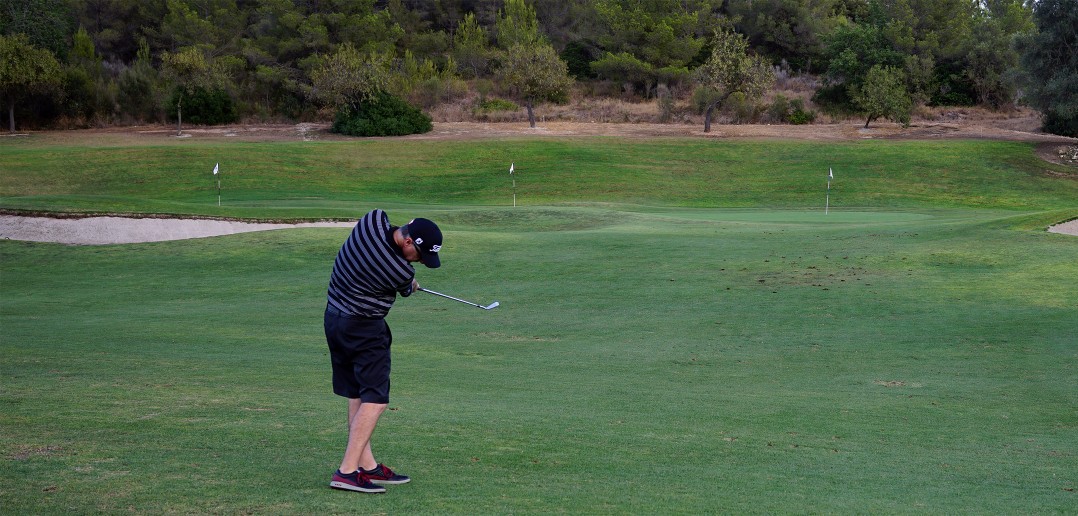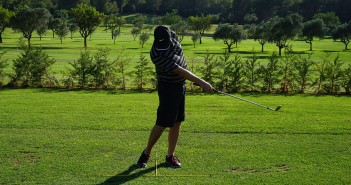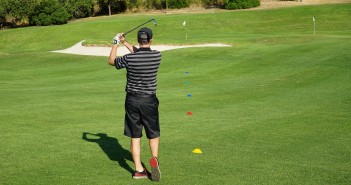The controlled fade is the favourite golf shot of most leading professional golfers, since it offers the most precise control over the golf ball. With this drill you’re going to learn how to play the controlled fade using exactly the same shot making techniques that are used by the best golfers in the world!
The vast majority of golfers have struggled, or are still struggling, with a slice. A slice is a huge, uncontrolled, fade, and you may think that hitting a fade should be second nature for most golfers since it’s played havoc with their game for so long!
But, unlike the horrid slice, the controlled fade is a fantastic weapon that can help you to dismantle a golf course, to go on the offensive and significantly lower your scores by plotting your way strategically around the course and attacking difficult pin positions with confidence.
The flight of the fade is easier to finesse, to control with precision, working the ball against the wind or guiding it in towards the flag, then landing it softly and stopping it quickly near your target – taking trouble out of play and working more effectively with the course topography and weather conditions of the day, making more birdies and saving more pars.
The master ball striker can use the fade to great effect, as many of the game’s legends have done, giving them a huge strategic advantage over the course and over their opponents. In this drill, we’re going to arm you with the knowledge that you need and show you how to take your shot-making skills to the next level, using exactly the same techniques used by the world’s greatest golfers. This is the next part of your road map to becoming a master shot maker.
This second drill in the “Working the Golf Ball” series forms part of the Golf Loopy Score like a Champion system for developing your wedge play, but this is also the best way to learn how to play these shots with any golf club. By starting with these shorter finesse swings, you will learn how to develop fine control over your swing path, club face angle and loft through impact in order to make the shots that you wish, on demand – something that you just can’t learn effectively at full speed.
But this drill isn’t just for the highly skilled golfer. It is just as effective for the golfing novice, the weekend warrior, or the chronic slicer. By learning how to exercise fine control over your ball striking, you will be able to hit the ball straighter, further, and more consistently, too. And, on days where your swing isn’t quite as good as it should be, you’ll be able to feel what is going wrong, to self-diagnose the problem, and to either fix your swing mid-round, or to work with your swing-of-the-day, manage your way around the golf course, and fix the problem later.
What is a Fade, and What Causes It?
Let’s start by describing what a fade actually is, and how it works. You don’t need to be an engineer to play a fade, but a basic understanding of the principles involved will help you to control these shots.
For the remainder of this article, we’ll describe the shot from the point of view of a right-handed golfer. Apologies to our lefty friends, but it’s simpler for everyone this way.
A fade is a shot that curves from left-to-right in the air, or that works against a right-to-left crosswind.
This can range from the huge sweeping slice, to the elegant little one-yard fade that holds the ball straight against a crosswind. In this article, we’re talking about how to play shots through the whole range, but they must be played with control.
A fade is caused by the ball having a spin axis that is tilted to the right. Spin creates lift, and a right-tilted spin axis will “lift” the ball to the right during its flight.
The spin axis is tilted when the club path (the direction that the club head is moving) is different to the direction that the club face is pointing through impact. For a fade, the club face must be pointing to the right of (be “open” to) the club path through impact.
The starting direction of the ball flight is determined, primarily, by the club face. The direction of curvature through the air (the spin axis tilt) is determined, primarily, by the club path relative to the club face. The face starts it, the path curves it. This relationship varies with the loft of the club. With a driver, the starting line of the ball is about 85% dependent on the club face angle, 15% on the path. With a mid-iron, the face has about 75% of the say in the direction that the ball starts. With a lob wedge the face has much less dominance – that’s why a flop shot, where the club face is way open and you have something approaching 80 degrees of loft through impact, doesn’t fly straight right.
There are other factors at play, such as the quality of the strike and gear effect, but those are discussed in detail elsewhere on this site. It’s important to be aware of these things, especially when diagnosing a missed shot, because your technique may be almost perfect but a mishit can turn a nice little fade into a nasty slice! Your first question after a missed shot should always be “Did I hit the ball cleanly with the middle of the club face?”
The simplest way to think of a basic fade is that, through impact, the club face is pointing half as much to the left as the club path. For example, a swing that is 6 degrees from the outside through impact, with a face angle that is 3 degrees closed to (pointing to the left of) the target, will produce a perfect little fade that lands by the pin – see Figure 1.
That may seem counterintuitive, a closed club face for a fade?! But the club face is open to the path, and the laws of physics mean that this will create a fade – starting the ball left and curving it to the right through the air.
Contrary to popular belief, for a controlled fade, the club face will rarely be open to your aim, and never open to the target! A club face that is open to the target will create a nasty push-slice that is the opposite of controlled.
Note also that the angles involved here are tiny. Six degrees is only one second on a clock face, yet it is enough to curve the ball 8 yards through the air for a 75 yard wedge shot (30 yards with the driver!) This is why we first need to learn to control the club with a finesse swing, rather than trying to feel such fine adjustments at 100mph!
The Drill
…
or Log In
…Ultimately, a great golfer, a master of his craft, won’t need to worry too much about technique. This golfer will look at the shot, visualise the ball moving through the air, react to the target and just think “fade”. It doesn’t much matter where their feet are pointing, it’s just a matter of feel. But you need to earn this level of control through intelligent practice.Work on this drill and, in no time at all, your ball striking will improve markedly, your confidence will soar, and you’ll have a fantastic tool to help you to dismantle a golf course.
Next up: We’ll teach you how to hit the ball high or low, giving you a huge range of shots and true mastery of shot-making, in Wedge Play Drill 109c – Technique: How to Control Trajectory.





